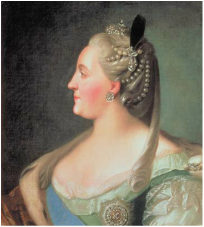|
Watching the current Inoculation Frolics, I was reminded of my recent reading of the superb biography, “Catherine the Great: Portrait of a Woman,” by Robert K., Massie.
In the spring of 1767, smallpox was rampaging through Russia. Catherine II, the German-born, French-speaking empress of Russia, saw a beautiful young countess die in mid-May. After that, Catherine took her young son and heir, Paul, into the countryside, avoiding all public gatherings. Catherine was well aware that smallpox vaccination was being done in western Europe and the British colonies. (Thomas Jefferson, 23, the squire of Monticello, had himself inoculated in 1767.) She sent for Dr. Thomas Dimsdale, 56, of Edinburgh, who arrived in August of 1768 and cautiously tried to inoculate other women before the empress, just to prove his process worked. (Massie notes that Dimsdale proclaimed Catherine, 39, “of all that I ever saw of her sex, the most engaging.”) However, Catherine bravely insisted she go first and he took a sample of smallpox from a peasant boy, Alexander Markov, and inoculated the empress on Oct. 12, 1768. She developed the anticipated modest amount of pustules and illness but was back in public by Nov. 1. The doctor inoculated 140 people in St. Petersburg and another 50 in Moscow, including Catherine’s son and grandson. Before Dimsdale returned to Scotland, she rewarded him with 10,000 pounds and a lifetime annuity. By 1800, over 2 million Russians had been inoculated. The final word belongs to Voltaire, as it often does. The French philosopher was a regular correspondent with Catherine, although they never met. Massie writes: “Catherine’s willingness to be inoculated attracted favorable notice in western Europe. Voltaire compared what she had allowed Dimsdale to do with the ridiculous views and practices of ‘our most argumentative charlatans in our medical schools.’” Fortunately, in these enlightened times, we do not have any “argumentative charlatans.”
ed martin
2/9/2015 06:24:23 am
As the saying goes, "those who do not know history are destined to repeat it. "
George Vecsey
2/9/2015 10:33:36 am
Ed, thanks. The line seems to be from Santayana, 1905: 2/10/2015 12:54:03 pm
George
George Vecsey
2/10/2015 02:31:21 pm
Yeah, but Washington and Jefferson did not have to pander to the Tea Party. GV Comments are closed.
|
Categories
All
|











